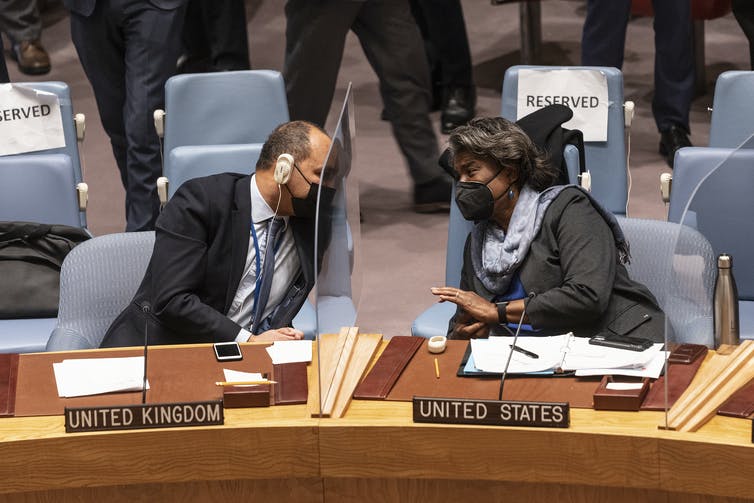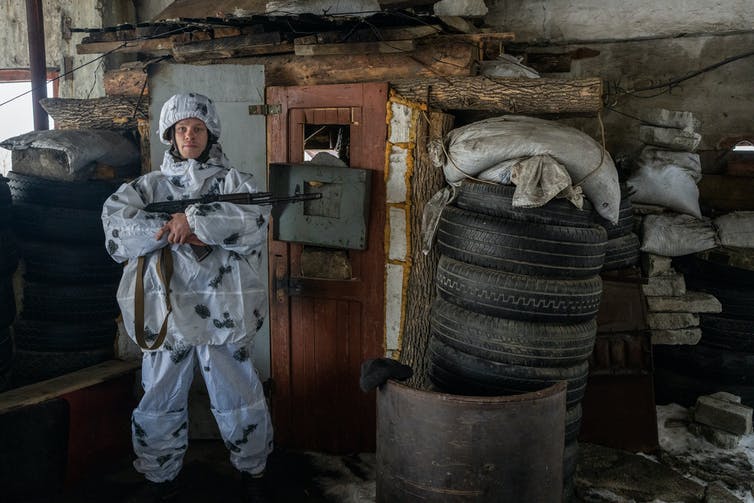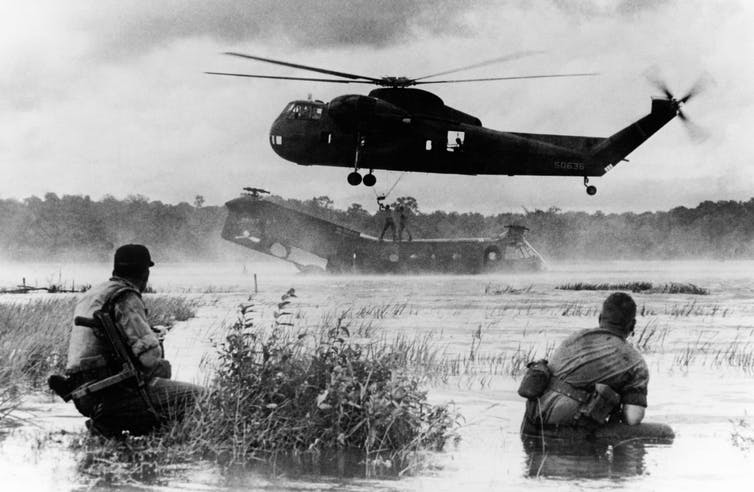An estimated 2,000 US troops are headed from the United States to Poland and Romania, which border Ukraine. The rest of the deployment troops will come from those already in Germany.
This move comes shortly after the Biden administration announced that it was putting 8,500 troops on high alert in response to the Russian military buildup of 100,000 troops along Ukraine’s borders.
the United States says that will not deploy troops to Ukraine, which is not a member of NATO. But what happens when the United States sends thousands of troops near Ukraine instead?
As national security experts, we believe there are some important factors to consider as the US military move may further increase tensions in Eastern Europe.
UK Ambassador James Kariuki and US Ambassador Linda Thomas-Greenfield speak during a United Nations Security Council meeting on Ukraine on January 21, 2022.
Does Biden have the authority to do what he is doing?
The United States Constitution establishes that the president is the Commander-in-Chief of the armed forces of the country. This role gives the president the ability to adjust the number of troops abroad, both in times of peace and crisis.
But the president’s use of this power has been controversial in the past.
Congress has tried to limit troop deployments to non-conflict areas. For example, him Senate held hearings in 1951 over whether the president could deploy more troops to NATO member countries in peacetime.
The witnesses, including former Secretary of State Dean Acheson, argued that the Constitution and the North Atlantic Treaty they guaranteed the president’s right to make such deployments.
The congress has the power funding the army and officially declaring war, and has debated limiting funds to different military operations for more than 100 years. But few political or legal measures have limited the president’s control over the military.
If it wants to limit the president’s power in this regard, Congress has two options: It can allocate zero dollars to the presidential plan, or it can pass a law actively prohibiting funding for that plan.
But actually cutting US military funding is hard. a president has certain capacity to transfer funds from existing military operations to others that are not fully funded.
For example, Donald Trump diverted funds from other military sources to build the border wall between the United States and Mexico in February 2020 at declare a national emergency.
Alternatively, if Congress passed a law that actively prevented spending in a specific area, the success of that bill would require a two-thirds majority vote of members of Congress to override a likely presidential veto.
The War Powers Resolution of 1973 – also known as the War Powers Act – is an example of a case in which Congress attempted to reassert its war powers and limit the president’s ability to unilaterally decide on military deployments.
However, the War Powers Act is unlikely to matter when Biden increases military deployments in NATO member countries.
One reason is that the Biden administration has explicitly said that US forces would not fight inside Ukraine and would defend it against a Russian invasion.
Many presidents of both parties have questioned the constitutionality of the War Powers Act. In recent decades, they have systematically invoked the constitutional powers of the article IIwhich make the president commander-in-chief of the armed forces, as the authority to carry out military operations.
At present, Congress has not yet successfully used the War Powers Act to withdraw military forces deployed abroad by a president.
A Ukrainian soldier stands guard outside a building in Maryinka, Ukraine, on February 2, 2022.
Have other presidents of the United States done something similar?
Past presidents have regularly deployed troops around the world, and have also deployed troops to regions facing rising tensions.
President John F. Kennedy, for example, increased the number of soldiers in South Vietnam from 700 to 16,000 in late 1963. This military buildup came eight months before Congress authorized the use of force in South Asia by the Gulf of Tonkin Resolution.
President George HW Bush deployed troops to the Middle East before Congress approved the First Gulf War in January 1991.
Historically, not all deployments like those in Vietnam or Iraq end in conflict.
In the past five years alone, the United States has created and relocated naval fleets in response to evolving situations in Europe and the korean peninsula.
President Barack Obama increased US military presence in Poland in 2016 for deter possible Russian threats.
Obama also increased military activity in Philippines Y Australia due to China’s territorial claims in the region.
In 2019, Trump deployed more troops in Saudi Arabia after heightened tensions with Iran.
A US Army helicopter rescues the crew of a damaged helicopter in Vietnam in 1963.
Why is Biden sending more troops to Europe?
Biden’s decision to send more troops to Europe can serve several purposes in the current crisis between Ukraine and Russia.
The repositioning of military personnel and assets before or during military crises is common. Biden’s decision could reassure current allies that the United States supports them and is committed to defending Europe.
The show of military force could also deter Russia from further incursions into Ukraine and build capacity to respond to a real invasion, should it occur.
Major military powers, such as the United States, often respond to military buildups with their own deployments. Our research shows that, even when responding to military actions by other countries, the major powers are cautious about keeping these deployments within their own spheres of influence – as the United States is doing – to avoid provoking a rival.
In general, the data show that additional US troop deployments in response to escalating regional concerns are commonplace.
The Biden administration is trying to demonstrate US support for NATO allies Y reassure allied countrieswhile hoping to deter a Russian incursion into Ukraine.
Michael A AllenAssociate Professor of Political Science, Boise State University; Carla Martinez MachainProfessor of Political Science, Kansas State Universityand Michael E FlynnAssociate Professor of Political Science, Kansas State University
This article was originally published on The Conversation. read the original.
Reference-www.eleconomista.com.mx


